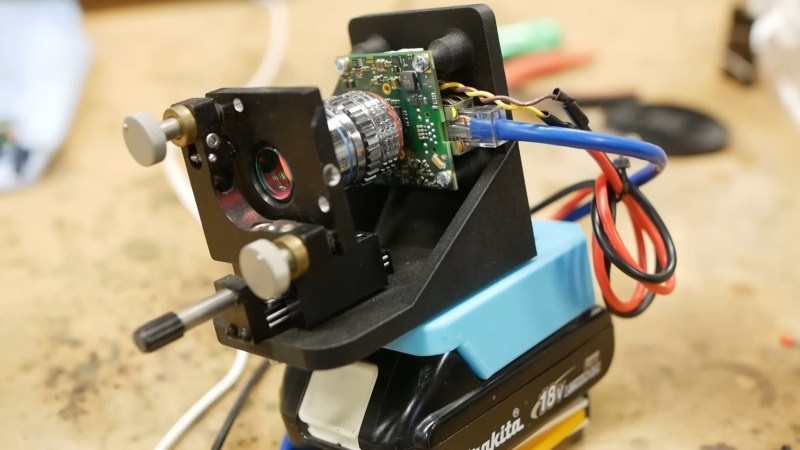Over on YouTube [Applied Science] shows us how to make an f/0.38 camera lens using an oil immersion microscope objective.
The f-number of a lens indicates how well it will perform in low-light. To calculate the f-number you divide the focal length by the diameter of the aperture. A common f-number is f/1.4 which is generally considered “fast”.
We are told the fastest commercial lens ever used had f/0.7 and was used by Stanley Kubrick to shoot the film Barry Lyndon which was recorded only with candle light.
A microscope objective is a crucial lens that gathers and magnifies light to form an image. It plays a key role in determining the quality and clarity of the final magnified image produced by a microscope.
In this case the microscope objective is optically coupled to the CMOS image sensor using a drop of oil. The oil has better refractive properties than an air-gap. In order to get the closest coupling possible the protective glass sheet on the top of the image sensor was removed. This process resulted in a lot of broken image sensors! Apparently the yield was only two working image sensors from eight attempts at removing the glass.
Of course we’ve seen f-number hacking here at Hackaday before, such as with the A Low F Number Lens, From Scratch which achieved f/0.5.
















Image produced should be front and center.
Otherwise assumed clickbait.
Dude. It’s Applied Science. You’ve never heard of them??
Spend some time on his channel. The fellow is a magician.
If you’ve spent any time on this channel you’ll know that HaHa never has anything useful to say.
Nope.
Not going to either.
Show me an image taken with the lens with claimed magic numbers first.
it’s a pretty valid image of the setup. One could argue it’s bad to lead with the same scene as in the thumbnail of the video… but I’m constantly seeing entirely different thumbnails since that’s now a thing for CTR optimization, so when HaD links to a video here, the thumbnail isn’t guaranteed.
How many minutes of clickbait do you have to watch before they reveal it doesn’t form a useful image?
skip to 4:12 for test footage
https://www.youtube.com/watch?v=DQv0nlGsW-s&t=4m12s
Another reason for oil immersion is that the wavelength of light is smaller in oil than in air. Smaller wavelength means better resolution; other things being equal and the optical system not being weirdly unusual.
As seen before on these very pages, but buried in the comments section from the last low f# article, back in April.
And the imposter commenting above is not me. I’m the original version, since 2008.
Just needs a “Recommend comment” field next to Report to submit comments into the tips line with sufficient consensus.
Or more likely they’ll get fat-fingered into the naughty queue.
It’s well known, in the scientific community, since decades, that oil immersion objectives can achieve much better f-numbers and resolution. I wonder why they haven’t made it to consumer products. Maybe because it complicates lens-swapping, that has been a huge source of income for manufacturers. Also, people take pride in their photographic equipment that they spent thousands on and they hate to see something cheaper and better. Does a too good system mean bad money?
Hmm, now I’m wondering why phone manufacturers don’t use it, seems simple to have a drop of oil in a tiny camera module.
Of course it is possible that there are ones that already use it.
Learn at least a little bit about optics before using the topic to express your general discontent with the world.
The quest for better lens assemblies is a process that has been going on for over two centuries, with the Gauss doublet proposed in 1817, the Double Gauss in 1888 and Cooke triplet in 1893. None of the early designs were really “fast” (as in exposure time), that is having a large aperture.
Given any particular design, stopping down a lens reduces the areas and range of angles across which light passes through the optical system to arrive at a single point in the image plane.
Modern lens designs are pushed in multiple directions during optimization, and that ultimately decides the cost of manufacture and image quality, and it’s a non-trivial task.
Two of the key difficulties are the acceptance angle of the sensor pixels which unlike film the lens has to match, and the mechanical back focal length of the lens.
The latter has ultimately contributed to mirrorless cameras having an advantage over DSLRs (see link below) and shaped the way modern smartphone camera assemblies look like, which also make heavy use of aspheric lenses to best match the image sensor.
Last point about faster lenses and why being able to have f/4 zoom lenses next to f/1.4 and f/1.2 primes is just better than wanting it all: I hope it has gotten out by now that we have swappable lenses for purely technical reasons, and that neither point&shoot nor smartphone camera systems have realized a major benefit from using oil immersion or cemented elements on the sensor despite their guaranteed sensor-to-lens pairing.
The third link finally leads to info on Sigma 28-45mm F/1.8 DG DN, which definitely isn’t an 18-135mm range one would consider “all-purpose” (minus long tele). Take a moment to admire the effort that went it with 18 lenses in 15 groups, and AR coatings on each lens.
The last time high numerical aperture made sense was in CD and DVD drive optical heads (solid immersion). You don’t always need oil for an immersion lens. In those drives, we took advantage of a 40 nm film of air, a length scale at which the 780 / 650 nm light would stop resolving the step in refeactive index.
https://www.bhphotovideo.com/explora/photography/features/lens-design-in-a-world-without-mirrors
https://optics.ansys.com/hc/en-us/articles/42661751764371-Designing-Cell-phone-Camera-Lenses-Part-1-Optics
https://www.dvxuser.com/threads/the-worlds-first-f1-8-full-frame-mirrorless-zoom-has-arrived.5711972/
What kind of oil do they use legitimate question lol
https://en.wikipedia.org/wiki/Oil_immersion